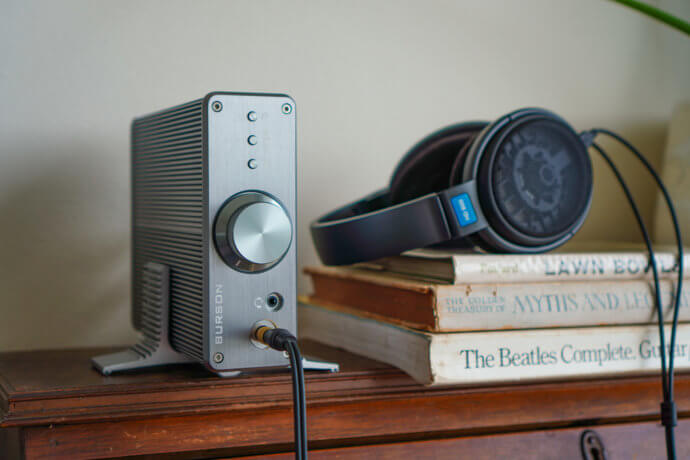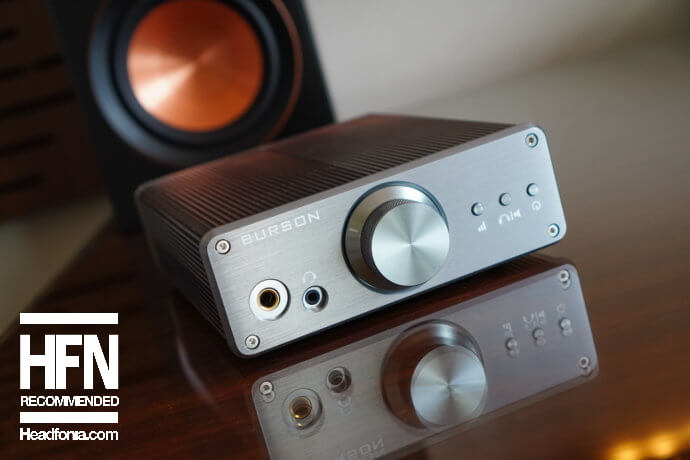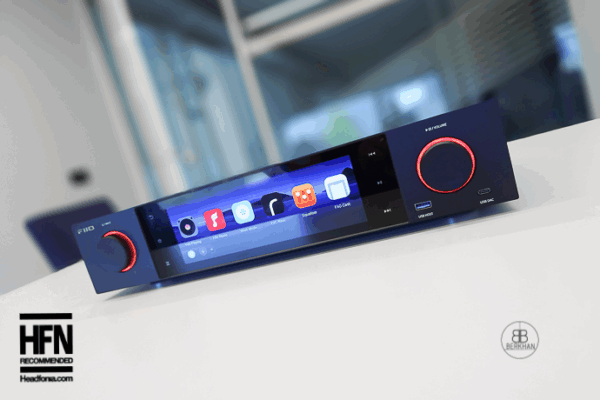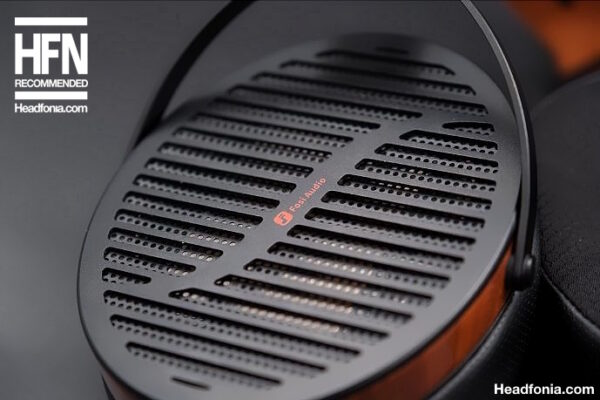In this review, we’ll be taking a look at the new Burson Funk – a compact integrated speaker/headphone amplifier from Australian hifi manufacturer Burson Audio.
Disclaimer: this Funk review unit was sent to us directly by Burson Audio for this review. Our thoughts and conclusions are our own.
The Funk is available from $544 USD in the ‘Basic Package’ directly from Burson Audio, or $744 USD for the ‘Deluxe Package’ which includes Burson’s V6 Vivid opamps as well as their ‘Cool Stand’.
The battle for desktop consolidation
If you’re anything like me, you might find yourself waging a constant running battle to keep your home office workspace as free from clutter as possible…and let’s just say that I’m definitely not always managing to win that battle. Granted, I do like to sprinkle my desktop with a little more audio gear than your average punter, but a cornucopia of black/silver boxes, cables, headphones, and speakers (in addition to your standard computing setup) ain’t always conducive to either productivity or aesthetics (Marie Kondo would probably have a coronary if she saw the viper’s nest of cables running around my office).
Throw a little bugger by the name of COVID-19 into the mix, and I, like many of you, have found myself spending upwards of 8 hours a day working from my home these days, meaning that a functional workspace is even more important than ever. But, every dark cloud has a silver lining, and for the housebound audiophile, this means a chance to spend day after day enjoying their gear and ploughing through albums and playlists aplenty (I’m not exactly in a rush to hurry back to the office anytime soon…). Working from home has sparked in me a newfound love of nearfield listening – popping a couple of speakers smack-bang on my desktop, setting the tweeters are at ear-height, and toeing them both in to point directly at my noggin. Yes, Headfonia is a headphone review website, but other things being equal, I’ll nearly always choose speakers over headphones. They’re simply more visceral, dynamic, and sound far more like you’re at a live performance…if you’ve set things up correctly, anyhow.
However, a good two-channel set-up is nearly almost more expensive and difficult to get great results compared to a good headphone set-up, because a) you need a lot more power; and b) you also have the room to contend with – I won’t delve too far into this subject here, but physics can be a right b*itch when it comes to managing standing waves and reflections, which simply aren’t a problem with headphones. Nearfield listening does eliminate many of these two problems, as you need only a fraction of the power required to get up to ‘party’ listening levels when the speakers are a foot or two away from your ears, and there are also fewer problems with regards to off-axis listening, reflections and the like (this is a gross oversimplification, naturally).
But, as we all know, things aren’t always ‘equal’. I can’t go cranking speakers while my other half is doing Zoom calls in the other room, and there are also times when I just crave the intimacy and insight that headphones can deliver in spades. And sometimes, I just need to block the world out – the Aeon 2 Noire has been pretty much exclusive strapped to my head from 8 am – 5 pm most weekdays while there’s been renovation work going on in my building for the last couple of months.
I’m not really a powered speaker kinda bloke – I love the more ‘pure’ experience of a dedicated pair of hifi passive speakers, and having the freedom to be able to mix/match/tinker with upstream source gear and amplification. This brings us back to the clutter conundrum – speaker amps, for the most part, aren’t exactly tiny. I have to stack my monitor on either a vintage NAD 3020e receiver or a custom NCore500 stereo power amp (yes, 400 watts per channel is a little overkill) to play my KEF LS50 speakers in my nearfield setup. This is in addition to having a DAC, a proper headphone amp, and occasionally a CD player (sorry, CD’s are awesome) or a turntable (yes, I’m that guy) also fighting for desktop real estate.

Burson Audio Funk
A new Downunder desktop contender has entered the ring
Hailing from Melbourne, Australia (about 1000km’s South of Headfonia’s Australian HQ), Burson Audio ought to be a familiar name for both Headfonia readers and fans of personal audio more broadly. Burson has been responsible for producing some of the best-performing (and best looking, IMHO) personal audio going round in recent years, no doubt adorning many a desk of you readers also parked firmly at home these days. You can check out some of our previous Burson Audio reviews here. While they do aim most of their gear squarely at the headphone crowd, they have dabbled with two-channel gear over the years, including the ‘Timekeeper Virtuoso’ stereo power amplifier. Burson is also well known for their finely-honed opamp technology (their opamps are sought-after as discrete units among the hifi community), and also their proprietary ‘Max Current Power Supply’ technology, which is better explained by them than by me.
Right on cue for the WFM phenomenon, Burson has now released a very interesting little device in their new ‘Funk’ – a compact integrated stereo amplifier with inbuilt headphone amplifier which is an apparent amalgamation of their recently retired ‘Bang’ compact power amplifier and ‘Fun’ headphone amplifier lines. The Funk sports Burson’s unmistakable new exterior design language, sporting the same finned ‘Cool Case’ as their Playmate 2 which I reviewed earlier this year. In fact, the Funk shares its chassis with the Playmate 2 which is designed not only to look, ahem, cool, but to also act as a heatsink to dissipate heat. Burson has launched the Funk at $544 USD for the ‘Basic Package’, or $744 USD if you tick the ‘Premium Package’, which gives you an upgrade to their Vivid V6 opamps as well as their ‘Cool Stand’ which allows you to orient the Funk on its side, making it an even more of a space-saving proposition.
Analogue, all-round
While many compact amplifiers employ a Class-D topology to keep weight, size and heat down, Burson decided that they didn’t want to settle for what they believe is an ‘inferior’ amplification technology, and instead decided to make the Funk a Class AB design capable of pumping-out 35 Watts into 8-ohm speakers, and 45 Watts into 4-ohm speakers. Considering that the Funk is about the size of a paperback novel, this is a pretty compelling proposition on paper and one that certainly piqued my interest. Unlike the Burson ‘Bang’, the Funk isn’t merely a power amplifier, but rather an integrated amplifier courtesy of its inbuilt volume control. Adding to the Funk’s desktop audiophile appeal is the fact that it’s also packing a headphone amplifier – not just a simple resistor off the power amplifier stage (like many stereo receivers have), but a proper discrete headphone amplifier – a Class A one capable of 3.5 Watts per channel (into 16 ohms), no less. In fact, it’s the exact same headphone stage as the very good one that sits inside the Playmate 2.
I mentioned before that Burson Audio is well known for their high-quality opamps that they’ve developed themselves in-house. While the ‘Basic Package’ option is equipped with two NE5532 opamps, these can be ‘rolled’ by the user – that is, they can be swapped out and changed with other Burson (or non-Burson) opamps to subtly change the Funk’s sound to the user’s preference, offering a nice future upgrade-path for the owner.
If you’re the type of person that’s keen to understand more about what’s going on under the hood of the Funk, its key specifications are as follows:
| Measurement | Package Content | ||
| Input impedance: | 38 KOhms | Burson FUNK (P-300) | Regional Power Cable |
| Frequency response: | ± 1 dB 0 – 35Khz | RCA Cables | Hex Key |
| THD: | <0.03% | Power Supply | 100-240V AC |
| Output impedance (Head Amp): | <2 Ohm | ||
| General | |||
| Inputs: | RCA Left / Right | Weight: | app. 3Kg |
| Outputs: | Headphone / Speakers | Dimensions: | 190mm x 150dimm x 60mm |
| Impedance (Headphone) | Power | Signal to Noise Ratio | Separation |
| 16 Ohm | 3.5W | 96db | 99% |
| 32 Ohm | 2.5W | 97db | 99% |
| 100 Ohm | 600mW | 98db | 99% |
| 150 Ohm | 400mW | 96db | 99% |
| 300 Ohm | 150mW | 95db | |
| Impedance (Speaker) | Power | Signal to Noise Ratio | Separation |
| 4 Ohm / 8 Ohm | 45W / 35W | 92.5db | 98.50% |
Click over to page 2 to continue the review.










Ivan
Hello Mathy Graham, My name is Ivan,
I need to know how to use the FUNK to My current PC Setup.
I am having a PC as source, and DACmini CX as DAC/AMP combo.
My PC is old, and the onboard output and mic input are terrible.
So I want to add FUNK as my speaker / headset amplifier.
As for the headset, do you think the mic pass through to the PC will bring the mic quality up? (As my motherboard onboard audio is terrible)
Thank you.
Matty Graham
Hi Ivan,
The DACmini should take care of your soundcare problems, if you’re connecting your PC to it via USB/Optical. From there, you would connect the RCA outputs of the DAC to the RCA inputs on the Funk.
I’m not sure about the mic quality however – the Funk is simply a ‘passthrough’. It would be the same as connecting a pair of headphones with an inline mic into the headphone adapter of your PC (if that can recognise a TRRS microphone input).
Best to test with an old pair of smartphone earphones with an inline mic (or your headset) to see if that works?
Ivan
Hi Matty,
So yes i had the DACmini served me well for years, but now i want to accomodate it for my son gamings peripheral too. The FUNK will not improve the mic quality as it just bypass it, so i think i better get the PLAYMATE2 to replace the DACmini.
Thanks for the respond.
Ivan
Hello Matty, i have questions:
“Firstly, the Playmate 2 doesn’t have a dedicated line out mode,
meaning that you’ll need to set the volume to ’99’ (= max), which takes a few cranks of the volume wheel to do so”
Q: When its paired with FUNK, do you mean that the playmate2 volume control also control the lineoutput volume ?
So that there is dual volume control here?
“and if we are getting technical, then you could also splice the pre-output of the Playmate 2 to a subwoofer as well”
Q: But how you are going to pair it with the FUNK, as there is only 1 output?
Thank you
Matty Graham
Yes, you can control the volume with either the Playmate 2 or the Funk. If you’re not using a subwoofer, I’d probably set the Playmate 2 to ’99’ and use the Funk’s pot to control the volume.
You can easily add a subwoofer (or other downstream device) by simply putting RCA splitters into the L/R outputs of the Playmate 2 – I just use these: https://www.jaycar.com.au/rca-plug-to-2-x-rca-socket/p/PA3560?gclid=Cj0KCQjwwY-LBhD6ARIsACvT72PAgTfZOu-s1-hltipgjAbK3yOCTPdKsVb8-rwWK4PGE-2SXJXatPMaAnIYEALw_wcB
BOL
Hi,
Currently trying to decide between the Funk or the Soloist 3x.
I don’t need the extra power as I’ll be using it primarily for IEM’s (Odins), but if the Soloist has better sound quality it would be worth it.
But if they basically sound the same and just have different applications (the Funk can power speakers, the Soloist can power demanding headphones) then the Funk will suit my needs.
Any thoughts?
Matty
Both are overkill for IEMs, you definitely don’t need a soloist. The Funk could be an ok solution if you need to power speakers too, but you’re probably better off with something much lower powered.
BOL
Thanks for the quick reply!
I know it seems like amps for full sized headphones like this is overdoing it, but I (and others) have found the Odins really scale up/are amp picky.
For instance, I’ve listened to the Odins extensively from my iBasso DX160, Gilmore Lite Mk2, and Cayin iHA-6 (and an old Asgard 2). The sound stage is small and congested with the 160 (it’s just ok for portable use), with the Mk2 the sound stage is pushed too forward (not enough depth) but there is more power and control, and with the powerful iHA-6 the sound stage really opens up, control and transients are superb, layering, instrument placement, and depth are much better, and the bass is much more powerful…the problem is there is a hardness/glare/metallicness to the iHA-6 I’ve never liked. (The Asgard I’ve never liked: just kind of a “rough” or “crude” sound to me which definitely drags down better gear like the Odin).
But besides power, what I’m really looking for is sound quality: is the Funk as good (or close to) the Soloist in terms of just the headphone out, or is it less refined, with less of a sound stage, less control, etc. I don’t want another middling mid-tier headphone amp; I want something that sounds excellent (has no significant defect like all my amps above do). But if the single out is essentially the same, then I don’t need the extra power.
It’s also possible, however, that at some point that I will jump into the high tier of headphones and the additional power will be needed or highly beneficial.
I would really like to be satisfied with just a $200 – $500 range amp here, but so far in that range, over many months of listening, I’m not. I’ve even blind tested and came to the same conclusions.
Thanks again for any advice!
BOL
Forgot all about this.
Just to follow up: I ended up ordering the Funk stock and it sounds very good with both my Odin IEMs (silent background too) and my HE1000v2.
The Funk is just on another level in terms of sound signature and technicalities over the Cayin iHA-6. There’s a lot more depth to the sound stage with better imaging (the Cayin is wider, but presents more of a flat wall of sound), the timbre is a lot more realistic (sounds “natural”), there is more impact/slam and weight to the notes, and the highs are natural, refined, and not fatiguing, at least to me, with the Odins and HE1000v2.
I also tested a friends Topping A90, and, to put it honestly, it sounded bad compared to all my other mid tier amps: just a cheap, clinical, cold, unresolving sound signature with edge/etch, glare, hardness, and a haze or gauze over everything. It was like the Cayin iHA-6 overall, only without any of the clarity and good technicalities that amp does have.
So, as I suspected, it’s not so much a matter of power as it is superior sound signature/technicalities and good IEMs and headphones will benefit from that. My next amp will be the Ferrum Oor that I will use with both my Odins and HE1000v2 that I’m sure will take both of them to the “final” level of performance.